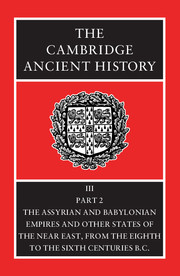Book contents
- Frontmatter
- Contents
- List of maps
- List of text-figures
- Preface
- PART I ASSYRIA AND BABYLONIA
- 21 Babylonia in the shadow of Assyria (747–626 B.C.)
- 22 Assyria: Tiglath-Pileser III to Sargon II (744–705 B.C.)
- 23 Assyria: Sennacherib and Esarhaddon (704–669 B.C.)
- 24 Assyria 668-635 B.C.: the reign of Ashurbanipal
- 25 The fall of Assyria (635–609 B.C.)
- 26 Assyrian civilization
- 27 Babylonia 605–539 B.C.
- 28 The culture of Babylonia
- PART II THE EASTERN MEDITERRANEAN AND THE BLACK SEA
- Chronological Table
- Note on The Calendar
- BIBLIOGRAPHY
- Index
- Map 11: Phoenician and Punic sites in Spain
- Map 13: Scythia
- Map 14: Thrace
- References
21 - Babylonia in the shadow of Assyria (747–626 B.C.)
from PART I - ASSYRIA AND BABYLONIA
Published online by Cambridge University Press: 28 March 2008
- Frontmatter
- Contents
- List of maps
- List of text-figures
- Preface
- PART I ASSYRIA AND BABYLONIA
- 21 Babylonia in the shadow of Assyria (747–626 B.C.)
- 22 Assyria: Tiglath-Pileser III to Sargon II (744–705 B.C.)
- 23 Assyria: Sennacherib and Esarhaddon (704–669 B.C.)
- 24 Assyria 668-635 B.C.: the reign of Ashurbanipal
- 25 The fall of Assyria (635–609 B.C.)
- 26 Assyrian civilization
- 27 Babylonia 605–539 B.C.
- 28 The culture of Babylonia
- PART II THE EASTERN MEDITERRANEAN AND THE BLACK SEA
- Chronological Table
- Note on The Calendar
- BIBLIOGRAPHY
- Index
- Map 11: Phoenician and Punic sites in Spain
- Map 13: Scythia
- Map 14: Thrace
- References
Summary
BACKGROUND AND GENERAL TRENDS
Babylonia in the early centuries of the first millennium B.C. reached a nadir in its history. Political power was effectively fragmented between a weak central government, semi-independent cities, and vigorous tribes who controlled substantial portions of the hinterland. The older settled population had declined significantly in size as well as influence, although the cities continued as religious and intellectual centres. Long stretches of watercourses, the lifelines of irrigation agriculture, were abandoned or had fallen into disuse. Recorded economic life had all but ceased, and there is no evidence for significant foreign trade being carried on by the settled population. Because of her political and economic debility, Babylonia's international horizons during this period were considerably narrowed; almost all known contacts were with her immediate neighbours to the north and east: Assyria, Luristan, and Elam.
In the six score years between 747 and 626 B.C., Babylonia underwent a substantial but gradual transformation from political and economic weakness to reinvigorated national strength on the threshold of territorial expansion. The Late Assyrian empire dominated most of south-west Asia during these decades. For Babylonia, Assyrian military and political oppression served in effect as a catalyst: it stimulated the people of the land to develop new social institutions, to heal political fragmentation, and to transcend military backwardness. The stabilization of the Babylonian monarchy under Assyrian occupation enhanced the economic environment and prepared the way for revitalization of urban structures. It is the purpose of this chapter to chart the career of Babylonia over these crucial decades and to probe the reasons behind the transformation.
- Type
- Chapter
- Information
- The Cambridge Ancient History , pp. 1 - 70Publisher: Cambridge University PressPrint publication year: 1992
References
- 2
- Cited by



